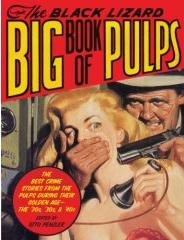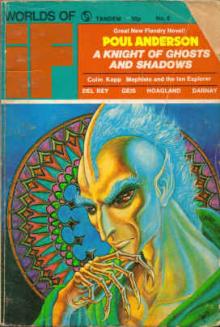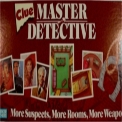Monday, January 28: The Scribbler
LOADED MAGAZINE
by James Lincoln Warren
 For Christmas, my wife got me Otto Penzler’s anthology The Black Lizard Big Book of Pulps, an epic collection of hard-boiled crime fiction from the 20s, 30s, and 40s. Highly recommended; it’s a wonderful collection and I have been enjoying every bit of it, even the abysmally bad writing of the genre’s inventor, Carroll John Daly. Most of the stories are from Black Mask, but all of them, even the two included novels, originally appeared in magazines.
For Christmas, my wife got me Otto Penzler’s anthology The Black Lizard Big Book of Pulps, an epic collection of hard-boiled crime fiction from the 20s, 30s, and 40s. Highly recommended; it’s a wonderful collection and I have been enjoying every bit of it, even the abysmally bad writing of the genre’s inventor, Carroll John Daly. Most of the stories are from Black Mask, but all of them, even the two included novels, originally appeared in magazines.
I remember well when novels were regularly serialized in magazines before they appeared in hardcover. Of course, all of Dickens’ novels originally appeared as serials, as did all four of the Sherlock Holmes novels. I remember reading George MacDonald Fraser’s Flashman at the Charge serialized in Playboy in advance of its publication as a book, likewise Poul Anderson’s A Knight of Ghosts and Shadows in the late pulp if (aka Worlds of If and if: Worlds of Science Fiction). I bought these magazines exclusively for the purpose of reading the serialized novels. (Even the copies of Playboy, honest.) Buying magazines containing serialized novels never prevented me from buying the books when they came out, either.
 In last week’s column announcing the Edgar nominations for best short story, I mentioned that the crime fiction magazines were beat out by anthologies both this year and last as sources for those nominations. I mentioned that I did not consider this a trend, given my understanding of the nomination process, and I still believe that it says more about the resurgence of the anthology than it does about the quality of the crime fic magazines. But I have to admit, trend or not — I’m concerned about the viability of magazine fiction for the future.
In last week’s column announcing the Edgar nominations for best short story, I mentioned that the crime fiction magazines were beat out by anthologies both this year and last as sources for those nominations. I mentioned that I did not consider this a trend, given my understanding of the nomination process, and I still believe that it says more about the resurgence of the anthology than it does about the quality of the crime fic magazines. But I have to admit, trend or not — I’m concerned about the viability of magazine fiction for the future.
In former days, there were numerous magazine titles. Harlan Ellison, in the introduction to Part II of Otto’s anthology, lists the the pulp magazines he wrote stories for: Manhunt, Mayhem, Guilty, Sure-Fire Detective, Trapped, The Saint Mystery Magazine, Mike Shayne’s, Tightrope, Crime and Justice Detective Story, and Terror Detective Story Magazine. All gone.
When I was in college, there were the following science fiction magazines: Galaxy, Worlds of if, Analog, Amazing Stories, Fantastic Stories, Isaac Asimov’s Science Fiction Magazine, and The Magazine of Fantasy and Science Fiction. More than half gone.
The alternative market from the pulps were the “slicks”: The New Yorker, Atlantic, Playboy, Esquire, and so forth. Cosmopolitan was mostly fiction before Helen Gurley Brown got her mitts on it in the 70s. All right, you can still read fiction in The New Yorker, if you’re into sophisticated ultra-hip Big Apple lit — but what about mainstream, commercial fiction like mysteries?
It has been said that fiction in magazines is irrelevant in the 21st century world. That maybe the long demise of fiction in magazines is simply a matter of Darwinism in publishing. The decline is most frequently traced to the influence of television and the internet as alternative sources of entertainment, and according to this wisdom, the invisible hand of market forces are inevitably forcing out the obsolescent periodicals. (I have also seen this argument used to explain why so many newspapers are failing.)
But maybe instead of being commensurate with a cyclical ice age that has no place for dinosaurs, it’s really the intellectual equivalent of industrial global warming. Maybe we are pouring so much intellectual garbage into the atmosphere that it’s choking off the cycle of life at its very foundations. If that’s the case, then don’t we have a collective responsibility to do something about it? Maybe this should be a clarion call to action. Save the planet, so to speak. Or at least that part of it that still can read.
What can you do to help?
Lock and load, baby.
Every time you finish reading a magazine, give it to someone else to read. Somebody different each time, though. Tell each person you so benefit to buy his own copy next time, and then to pass it on to someone else as you have done. Now there are two people buying magazines with fiction instead of just one. And possibly more.
Buy extra copies of Hitchcock or Queen and seed them in dentist’s offices and other lobbies. Be sure to include the subscription cards.
Casually ask your friends if they have the latest issues and then talk about the stories you liked best when hovering around the water cooler at work — you know, the way you might talk about football or “Desperate Housewives”: “Did you catch Estleman’s latest in Queen? Awesome.” Make them feel unhip and out of touch if they don’t understand what you’re talking about.
Scowl at every magazine you see that doesn’t publish fiction, even though it may contain such salutary features as sexual IQ quizzes, holiday recipes, and blonde blue-eyed cheesecake, declaiming loudly, “How can you read this crap? Why don’t you subscribe to Hitchcock instead?”
Take no prisoners.




















‘Loaded Magazine’ has a great double meaning, particularly following John’s article from Saturday.
The slick Omni Magazine was another sad demise, which carried both fiction and a great puzzle section.
By implication, Ellery Queen and Alfred Hitchcock Mystery Magazines must be the top of the Darwinist food chain!
However, I was surprised James’ article didn’t mention the April issue of Alfred Hitchcock (soon to arrive at newsstands) containing stories from Rob, James, and Leigh. What a great issue (he says modestly). You will not figure out Rob’s twist.
My co-worker is from England. Very well read, literary free-lance, etc etc, she said she’d started reading graphic novels. A friend of hers is on sabbatical from Leeds studying this form of “literature.” Basically it is an upgrade comic book, with serious matter. For instance, she is reading the state of Iraq before the war up to now (which would lead me to wonder WHO wrote it (or drew it).
My son is a latin teacher and getting a 2nd master’s in linguistics and just got back from teaching at a private university outside Istanbul. I asked him what he thought and while I can’t repeat everything he said he basically said it bothered him that reading was secondary to “following the yellow brick road” of cartoons. He did say they were a rage in the high schools and college age.
he basically said it bothered him that reading was secondary to “following the yellow brick road” of cartoons. He did say they were a rage in the high schools and college age.
My concern is if we allow cartoons to take the place of written word, what next? We already have a computer/game/fantasy laden generation in full bloom.
I give my books to friends, neighbors, retirement centers and nursing homes.
Alisa, I recently saw a news item about how much African children valued reading and were willing to walk miles for their education.
That’s wonderful. Wouldn’t it be nice if it were that way here.
Leigh wrote some time ago about the emerging “cell phone novel” in Japan, characterized by by language reduced to its most basic forms. According to The New York Times, these are read and written by teenage girls who generally do not read any prose at all except for manga, Japanese comic books and find “traditional” novels too hard too read.
On the other hand, I know a number of writers who write or have written graphic novels — although I would quibble with Alisa’s definition of a graphic novel as an “upgrade comic book, with serious matter”, since the subject matter is not relevant. The only differences between a graphic novel and a mainstream comic book is the paper it is printed on and the fact that a graphic novel has limited run. But getting back to writers — these writers (Gregg Hurwitz, Gary Phillips, Todd Livingston) are just as dedicated to literacy as any one else. I taught myself to read with comic books. I do not regard comics as The Enemy.
The Enemy are media that Marshall McLuhan described as “cool” like TV, i.e., media that require no volition on the part of the audience, and “post-literate” media like electronic games, which devalue literacy.
A quibbler at heart…..
This definition is from Wikipedia and most that I could find, I still stick by my definition.
The evolving term graphic novel is not strictly defined, and is sometimes used, controversially, to imply subjective distinctions in artistic quality between graphic novels and other kinds of comics. It suggests a story that has a beginning, middle and end, as opposed to an ongoing series with continuing characters; one that is outside the genres commonly associated with comic books, and that deals with more mature themes. It is sometimes applied to works that fit this description even though they are serialized in traditional comic book format. The term is commonly used to disassociate works from the juvenile or humorous connotations of the terms comics and comic book, implying that the work is more serious, mature, or literary than traditional comics. Following this reasoning, the French term Bande Dessinée is occasionally applied, by art historians and others schooled in fine arts, to dissociate comic books in the fine-art tradition from those of popular entertainment, even though in the French language the term has no such connotation and applies equally to all kinds of comic strips and books.
Which only goes to show why you should never rely on Wikipedia.
Personally, I find the idea that “graphic novels” are more serious or literary than “comic books” to be outright laughable.
There is really no substantive difference between the two, other than that comic books are printed on pulp and graphic novels on slick paper. Graphic novels have a limited run or four to six issues and comic books are open-ended.
The attempt to differentiate one from the other is motivated by a desire to elevate the genre from low brow pop culture to something more sophisticated. Anybody who takes comics seriously, as I do, will find the attempt transparently snobbish.
Carl Banks’ “Donald Duck”, a juvenile humor comic, is generally considered to be one of the masterpieces of the genre. The famous “Phoenix Saga” in The Uncanny X-Men, the high water mark of comics in the late 70s and early 80s, was printed in the regular monthly magazine.
The only real distinction in the comics universe that should be made is between comic books and comic strips. The best of the best are the latter: Krazy Kat, Prince Valiant, Tarzan, Flash Gordon, Gasoline Alley, Dick Tracy, etc.
James, I too regret the passing of the old longlost mystery magazines, and even some of the smaller, more recent pubs like Mystery Time, Red Herring Mystery Magazine, etc. One that’s still around, though, and that you didn’t mention, is The Strand Magazine, which was reborn a few years ago under the leadership of Andrew Gulli. There’ve been some good stories in there.
There’s a link to The Strand’s website at right on the Sidebar, under “Lex Artis”.